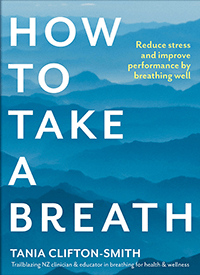Breath expert Tania Clifton-Smith reveals her secrets to breathing well
- 10 November 2021
Tania Clifton-Smith is a clinician and educator in breathing for health and wellness. In this extract from her new book, How to Take A Breath, she explains why there is more to it than just breathing in and breathing out.
Over the last three decades my work in the field of breathing pattern disorders, breathing dysfunction and hyperventilation has been rich. My background training in physical education and physiotherapy has provided an ideal foundation for this field of practice and I have never stopped learning. My journey in this field began treating the literati, glitterati and high achievers at the top of their professions in London in the late 1980s.
These clients had all been diagnosed with exhaustion, burnout and chronic hyperventilation syndrome (CHVS). Another wing of the practice was the treatment of survivors of torture. This group was also suffering from exhaustion and CHVS, but with added severe psychological trauma and pain. My learning curve was steep, challenging and stimulating, and I was hooked.

Tania Clifton-Smith started helping people with their breathing in the 1980s.
Working with both groups, as well as developing some unique therapeutic skills, I also gained priceless experience that covered the spectrum of what it is to be human. I also learnt that my background in physiotherapy and physical education was not enough for me to be able to understand and treat such conditions. There began my never-ending thirst for knowledge, honing of skills and people-contact in this field. One kind friend has even labelled me a self-confessed course-a-holic in the field of breathing!
Since then, my clinical practice has explored many aspects of breathing dysfunction. From the purely mechanical – for example, mouth breathing in children, and back and neck pain driven by breathing pattern dysfunction – to elite athletes who have postural breathing problems on a quest to move faster, to individuals with biochemical imbalances making them sensitive to all stressors as a result of having lower blood carbon dioxide levels than normal.
Many fall into this common, silent, unknown category. I’ve also sought to understand the body’s neuropsychophysiology, which affects thoughts and emotions and includes areas such as insomnia, panic attacks and overwhelming stress. One thing I know for sure is you cannot breathe well and be experiencing panic – it’s physiologically impossible.
Most people don’t know that breathing is also connected with movement, sleep, bowel motions, feelings, thoughts, general health and performance, and voice control. There is more to breathing than just breathing in and breathing out. Breathing is the first step to overall health, movement and well-being.
I don’t believe the message of the importance of breathing well is being heard. Breathing well has a profound effect on health and well-being and it is not as simple as some would like to imagine. Breathing is complex. There are many things that affect the way we breathe, and the way we breathe will affect many things.
Generalised breathing protocols do not fit everyone, especially if there is some dysfunction. Those people need an individualised, tailor-made programme. However, there are general principles that apply to many people – if they know what to look for.
In today’s society, pressure is paramount, change is inevitable, and the speed and volume of communication is only going to increase. Those with the tools, resilience and the ability to adapt will thrive. Those without, will not. It’s as simple as that.
As a clinician, I am deeply passionate about the importance of breathing well and still see it as an untapped tool that everyone has immediate access to, which will help improve health and well-being. Breathing is the most fundamental function to help regulate many systems. It’s a key to better self-understanding. We can tune into it anywhere and anytime, and it is drug-free.

Breathing is the first step to overall health, movement and well-being.
In our clinic, we say: ‘Breathing is the conductor of the orchestra’. It influences all the body’s organs and functions. Extended time without air is deadly, and we need to keep breathing for survival. Ultimately, everything the body does is to ensure cells are well oxygenated, carbon dioxide balanced and we continue breathing.
Over the past decade, science and the medical profession have started taking note and now more physicians will consider breathing therapies/breathing rehabilitation as treatment options for numerous conditions and disorders.
Because there are many things that drive altered breathing, some of which are driven by a disease base and some that are not, it helps to unpack the puzzle of why an individual’s breathing changes, as this then often determines the treatment programme. Clinically, I’ve seen the age of clients get younger and younger – in particular, those experiencing stress, anxiety and panic-related issues. This concerns and frustrates me. Breathing awareness and simple strategies should be taught immediately to everyone presenting with symptoms. They can be taught instead of or in conjunction with cognitive thought strategies and medication.
We’ve had the mindfulness wave. This is a start. Breathing therapies are similar but distinctly different, and for many they are an as yet untapped resource.
Breathing well affects all our body’s systems. All areas of the body are interconnected, and if we are breathing well, we’ll experience many positive improvements.

How to Take a Breath, by Tania Clifton-Smith
Three exercises to know : A sample of some techniques detailed in the book
BradCliff Five by Fives for recovery breathing
Prolonged over-breathing quickly depletes the body of carbon dioxide. This can cause distressing symptoms like tingling finger-tips or lips, light-headedness, poor balance or panicky/nauseous feelings. If you experience this, try this effective and discreet way of restoring CO2 levels that places you in control.
- Cup both hands over your nose and mouth.
- Breathe softly in and out through the nose five times.
- Drop your hands to your lap and count to five.
- Repeat breathing with cupped hands, counting each breath in and out, up to five again.
- Repeat this five by five sequence until the symptoms subside.

Grounding is a great exercise to de-stress.
Grounding exercise
This is an excellent exercise to use in all-time stress-out situations. The aim of it is to bring awareness to the present moment to distract us from our thoughts. It can be done either standing or sitting.
- Focus on your feet.
- Feel your toes, heels and the soles of your feet on the ground beneath you.
- Relax your knees.
- Drop your shoulders.
- Focus on your out breath.
- Now breathe in nose, low and slow.
- Breathe out.
- Pause.
- Feel your feet on the ground and continue what you were doing.

Stretches provide instant energy by increasing the flow of blood to the brain.
Instant, energising breathing stretches
These stretches provide instant energy by increasing the flow of blood to the brain.
- Stand with your feet shoulder-width apart.
- Tail tuck (tilt your pelvis under) then inhale.
- Lift both arms above your head.
- Interlock your fingers then stretch up.
- As you breathe out, let your arms come back down to your sides.
- Repeat three times.
- How To Take A Breath by Tania Clifton-Smith is out now

